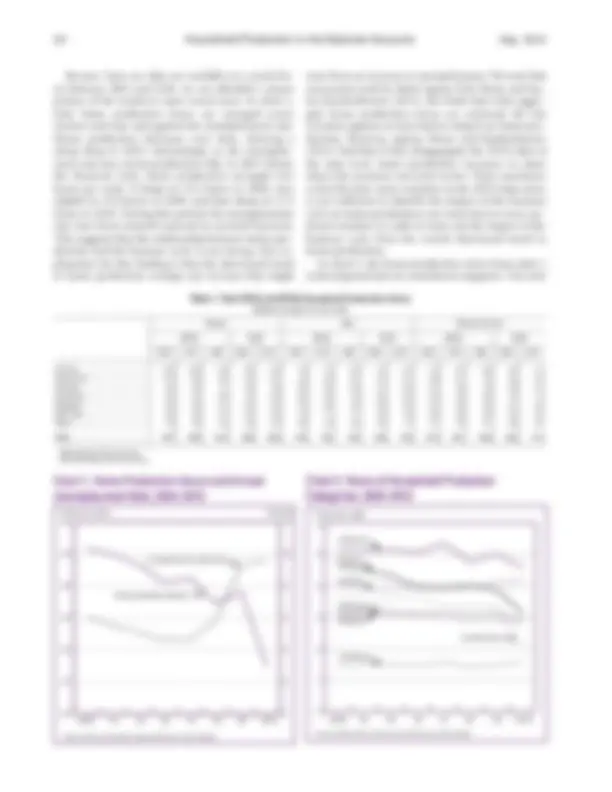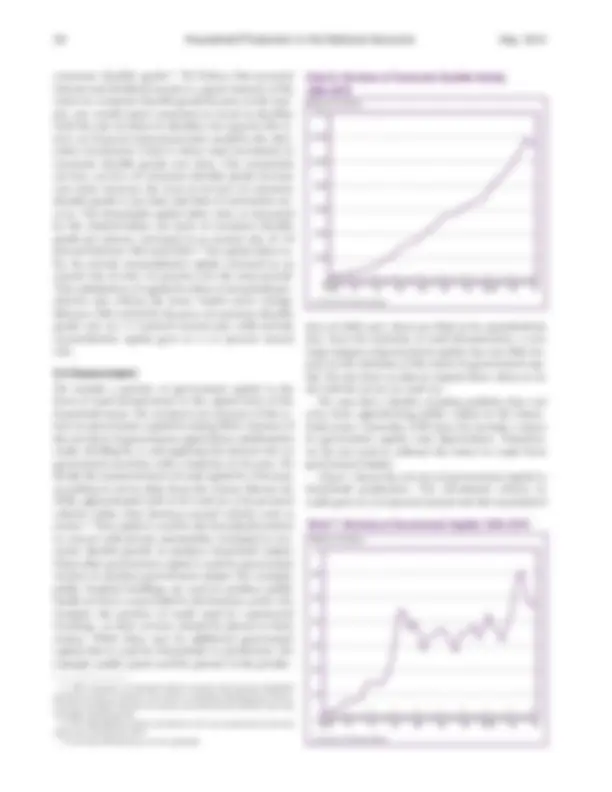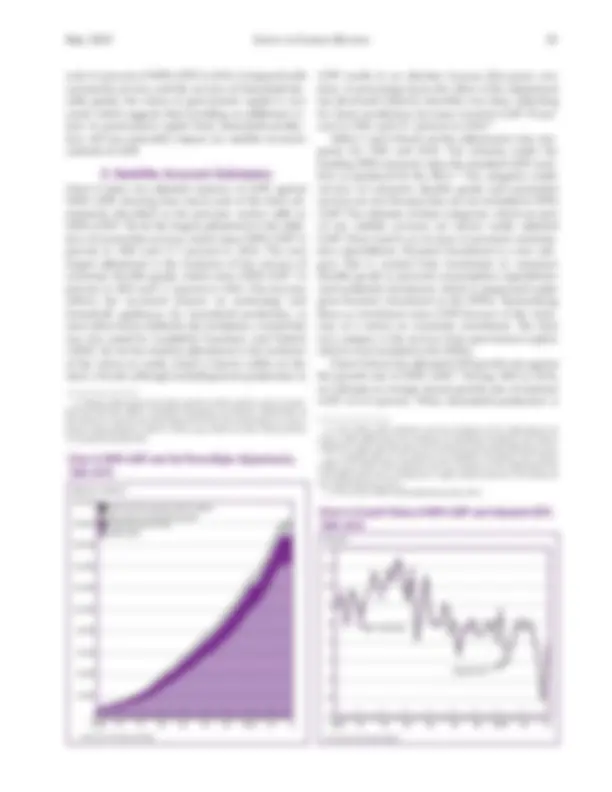










Study with the several resources on Docsity

Earn points by helping other students or get them with a premium plan


Prepare for your exams
Study with the several resources on Docsity

Earn points to download
Earn points by helping other students or get them with a premium plan
Community
Ask the community for help and clear up your study doubts
Discover the best universities in your country according to Docsity users
Free resources
Download our free guides on studying techniques, anxiety management strategies, and thesis advice from Docsity tutors
The decline in home production hours and its effect on measured GDP growth and income inequality. The authors find that home production hours have decreased over time for both employed and not employed women, and this decrease has driven a decrease in the number of household production hours spent by women who do not enter the labor force. The document also notes that the correlation between home production hours and income is small, especially for women, and that the return to government capital from household production is very small. The authors suggest that the increase in reliance on technology and household appliances for household production is a contributing factor to the decrease in home production hours.
Typology: Lecture notes
1 / 14

This page cannot be seen from the preview
Don't miss anything!









May 2012 23
ONMARKET production has long been a subject of interest to national accountants and econo mists, dating back at least to the seminal work of Si mon Kuznets (1934). Since the inception of the national income and product accounts (NIPAs) in the 1930s, issues have been raised about the scope and structure of the accounts. Kuznets, one of the early ar chitects of the accounts, recognized the limitations of focusing solely on the measurement of market activi ties and excluding a broad range of other nonmarket activities that have productive value such as household production. And although the national accounts are now recognized as one of the most successful analytical measures in the United States, various supplemental series and accounts have been developed to account for a broader set of activities outside of the market econ omy that may offer further sources of economic growth. For example, William Nordhaus and James Tobin in the early 1970s developed a major set of extended ac counts that tackled the broader measurement of wel fare; those accounts added imputations for government and household capital services, nonmar ket work, and a major imputation for the value of lei sure. The effect was significant, as the imputations nearly doubled gross national product (GNP) in 1965 (Nordhaus and Tobin 1973).^1 Throughout the 1970s and 1980s, Dale Jorgenson with Laurits Christensen, Barbara Fraumeni, and Alvaro Pachon developed a system of national accounts that vastly expanded mea sures of consumption and investment (Jorgenson and Christensen 1969, 1973; Jorgenson and Fraumeni 1980, 1989; Jorgenson and Pachon 1983). Jorgenson and colleagues not only accounted for household phys ical capital services, household production, and lei sure, but they also quantified the impact of investment in human capital on GDP. In a particularly important series of papers, Jorgenson and Fraumeni (1989, 1992a, and 1992b) developed the lifetime incomes ap proach to valuing investments in human capital, which in combination with other imputations, added roughly
$14 billion to GDP for 1984, almost 4.5 times as large as the unadjusted value of GDP for 1984. Work by John Kendrick and Robert Eisner also sug gested expanding the boundaries of investment to include investments in capital of all kinds, including investment in tangible human capital and in intangible investments such as research and development. Kend rick’s set of expanded income and product accounts
Summary of Findings This paper develops a satellite account that adjusts gross domestic product (GDP) for household produc tion between 1965 and 2010. The primary findings are as follows: ● Incorporating the value of nonmarket household production raises the level of nominal GDP 39 per cent in 1965 and 26 percent in 2010. The decline reflects the steadily decreasing number of hours households spent on home production. ● In 1965, men and women spent an average of 27 hours in home production, and by 2010, they spent 22 hours. This overall decline reflects a drop in women’s home production from 40 hours to 26 hours, which more than offset an increase in men’s hours from 14 hours to 17 hours. ● The downward trend in the hours spent on non- market household production appears to be unaf fected by the 2007–2009 recession, despite the increasing number of unemployed household members. ● Including the value of household production lowers measured GDP growth by accounting for the losses in home production associated with increases in women’s labor force participation and in market wages between 1965 and 2010. Over this period, adjusting nominal GDP for home production low ers growth from 6.9 percent to 6.7 percent. ● Home production reduces measured income in equality. Although households engage in a similar number of hours in home production regardless of income, adding a relatively constant value of home production to all households proportionately raises the income of low-income households more than that of high-income households.
24 Household Production in the National Accounts May 2012
resulted in a 34 percent increase in GNP in 1969 (Ken drick 1976). Eisner (1989), in his attempt at folding in the work of many of his predecessors, published a set of “Total Incomes System of Accounts,” resulting in an adjusted GDP for 1981 that was 1.5 times larger than the unadjusted value. We contribute to this body of literature by con structing a “satellite account” estimate of GDP that in corporates the value of production by households. We measure three different types of home production ac tivities: the production of nonmarket services, the re turn to consumer durable goods, and a return to government capital attributable to home production. The most significant, in terms of its impact on GDP, is the production of nonmarket services, such as cook ing, gardening, or housework. To measure the value of nonmarket services, we make use of two unique sur veys that track household labor activities and apply a wage to the total number of hours spent in home pro duction.^2 One of these surveys is the Multinational Time Use Survey (MTUS), which combined a number of time use surveys conducted by academic institutions into a single data set. These surveys were taken sporad ically between 1965 and 1999. The other is the Ameri can Time Use Survey (ATUS) produced by the Bureau of Labor Statistics (BLS). This survey was taken annu ally between 2003 and 2010. The second type of home production activity we measure is the return to con sumer durable goods, which we treat as investment rather than as consumption, as is currently the case in the NIPAs. The third type of home production in volves computing a return to government capital that can be attributed to home production. We note that exercises similar to ours have been conducted by Steve Landefeld, Fraumeni, and Cindy Vojtech (2009) and Landefeld and Stephanie McCulla, (2000). Our paper contains two extensions of this pre vious work. First, we can examine the impact of home produc tion over a business cycle. This was not possible for Landefeld, Fraumeni, and Vojtech (2009) to do as a re sult of the way in which the ATUS and MTUS data were collected. Landefeld, Fraumeni, and Vojtech (2009) computed the impact of home production us ing methodology that we subsequently used for 1965 to 2004. They combine the MTUS data and the ATUS data into a single time series that tracks household la bor activities over this period. However, the MTUS survey was only conducted five times between 1965 and 1999; household labor values are interpolated be
tween surveys, meaning that it is impossible to observe the impact of the business cycle on home production for this period. They also only used 2 years of ATUS data, 2003 and 2004, that do not cover a business cycle. Second, we merge the 7 years of ATUS data with the Current Population Survey (CPS) data on household income and examine the relationship between home production and inequality. We find that incorporating home production in GDP raises the level of GDP 39 percent in 1965 and 25.7 percent in 2010. The impact of home production has dropped over time because women have been en tering the workforce. This trend is driven by an in creasing trend in the wage disparity between household workers and employees (that is, the oppor tunity cost of household labor). This disparity has led to a decrease in the number of nonmarket labor hours spent by both employed and not employed women. The fact that women have been entering the workforce over time also means that the growth rate of the tradi tional measure of GDP will be higher than our ad justed measure. Because standard GDP does not account for home production, some of the increase over time in GDP will be due to women switching from home production to market-based production. Our adjusted GDP measure includes the unmeasured home production, so the increase in GDP that occurs due to substitution from home production to market- based production will be smaller. During 1965 to 2010, the annual growth rate of nominal GDP was 6.9 per cent. When household production is included, this growth rate drops to 6.7 percent. While inclusion of the value of nonmarket services accounts for most of the impact of the adjustment of GDP for home production, returns on consumer dura ble goods also matter. We treat consumer purchases of durable goods, measured in the Bureau of Economic Analysis (BEA) personal consumption expenditures, as investment and compute a measure of capital services attributable to them. Overall, however, the returns to consumer durable goods are about half the size of the value of nonmarket services. The smallest adjustment by far is the inclusion of an extra return to government capital. However, we note that the only government service we feel that we can reliably assign to home production is road use (see section 2.3). Drawing on information from a Census Bureau survey, we assign 50 percent of the value of road capital to personal transportation and add a measure capital services to this value. Turning to the impact of the 2007–2009 recession, we find the impact on home production was small. From 2007 to 2010, home production drops by a little less than 3 hours per person per week, with a slight
26 Household Production in the National Accounts May 2012
Because time use data are available on a yearly ba sis between 2003 and 2010, we are afforded a clearer picture of the trends in more recent years. In chart 1, total home production hours are averaged across women and men and against the unemployment rate. Home production decreases over time, showing a sharp drop in 2010. Interestingly, as the unemploy ment rate rises, home production falls. In 2007, before the financial crisis, home production averaged 24. hours per week. It drops to 23.5 hours in 2008, rises slightly to 23.8 hours in 2009, and then drops to 21. hours in 2010. During this period, the unemployment rate rises from around 6 percent to around 9 percent. This suggests that the relationship between home pro duction and the business cycle is not strong. One ex planation for this finding is that the downward trend in home production swamps any increase that might
arise from an increase in unemployment. We note that concurrent work by Mark Aguiar, Erik Hurst, and lou kas Karabarbounis (2011) also finds that when aggre gate home production hours are analyzed, the last recession appears to have had no impact on home pro duction. However, Aguiar, Hurst, and Karabarbounis (2011) find that if they disaggregate the ATUS data at the state level, home production increases in states where the recession was more severe. Their conclusion is that the time series variation in the ATUS data series is not sufficient to identify the impact of the business cycle on home production; one must turn to cross-sec tional variation in order to tease out the impact of the business cycle from the overall downward trend in home production. In chart 2, the home production series from chart 1 is decomposed into its constituent categories. The only
Table 1. Total ATUS and MTUS Household Production Hours [Weighted average hours per week] Women Men Women and men MTUS ATUS MTUS ATUS MTUS ATUS 1965 1975 1985 2003 2010 1965 1975 1985 2003 2010 1965 1975 1985 2003 2010 Cooking ........................................ 12.8 10.8 9.2 5.9 5.9 1.8 1.5 2.5 1.9 2.4 7.5 6.4 6.0 4.0 4. House work .................................. 11.5 9.6 9.3 7.5 6.7 1.8 2.3 5.1 2.7 2.7 6.8 6.1 7.3 5.2 4. Odd jobs....................................... 3.2 3.0 1.1 4.5 2.9 2.9 4.0 2.5 4.7 3.5 3.1 3.5 1.8 4.6 3. Gardening..................................... 0.4 0.4 0.8 1.0 0.9 0.3 0.3 1.0 2.0 2.3 0.3 0.3 0.9 1.5 1. Shopping ...................................... 2.8 3.6 4.1 3.6 3.3 1.8 2.0 2.5 2.5 2.3 2.4 2.9 3.3 3.1 2. Child care ..................................... 4.8 3.9 3.7 4.4 3.9 1.2 1.1 1.1 1.8 1.8 3.0 2.6 2.4 3.2 2. Travel ............................................ 4.3 4.6 4.3 4.0 2.3 3.9 4.0 3.9 3.3 1.7 4.1 4.3 4.1 3.6 2. Total ............................................. 39.7 36.0 32.4 30.9 25.9 13.6 15.3 18.5 19.0 16.8 27.2 26.1 25.8 25.2 21. ATUS American Time Use Survey MTUS Multinational Time Use Survey
Chart 1. Home Production Hours and Annual Chart 2. Hours of Household Production
Unemployment Rate, 2003–2010 Categories, 2003–
Hours per week
Unemployment rate (right axis)
Percent
Sources: Bureau of Economic Analysis and Bureau of Labor Statistics
12
10
8
6
4
2
0
26
25
24
23
22
21
20 2003 04 05 06 07 08 09 2010
Home production (left axis)
6 5 4 3 2 1 0
Hours per week
Source: American Time Use Survey from the Bureau of Labor Statistics
Housework
Odd jobs
Cooking
Gardening
Domestic travel
Shopping
Child care
2003 04 05 06 07 08 09 2010
May 2012 SURVEY OF CURRENT BUSINESS 27
Hours per week
U.S. Bureau of Economic Analysis
40
35
30
25
20
15
10
5
0
Chart 3. Home Production Hours by Income Level, 2003–
Chart 3. Home Production Hours by Income Level, 2003–
2003 04 05 06 07 08 09 2010
Women, top income level Women, middle income level Women, bottom income level
Men, top income level Men, middle income level Men, bottom income level
significant change is in travel and odd jobs. Travel dropped sharply in 2010, consistent with the sharp drop in overall home production in that year. Some of this drop may be due to the high unemployment rate, which would reduce commuting time. However, the unemployment rate in 2009 was almost as high as in 2010, yet travel time remained at almost the same level as in 2008. Odd jobs has steadily dropped from a little over 4.5 hours in 2003 to just above 3 hours in 2010. To summarize, from 1965 to 2010, we observe an overall drop in home production hours. Because of this, the impact of home production on the level of GDP would decrease over time, and the measure of GDP adjusted for household production would grow at a slower rate than unadjusted GDP.
1.3 Home production and inequality
Many economists have been interested in the impact of nonmarket activity on the distribution of income. Us- ing data from 2003, Harley Frazis and Jay Stewart (2006) find that including household production de- creases income inequality. Individuals have a similar amount of household production regardless of house- hold income. Household production adds a constant amount of income that increases income for low-in- come families proportionally more than for high-in- come families. Since the importance of household production has been decreasing over time, its impact on inequality has likely been declining as well: the amount of extra income added to each household’s in- come will decline from one year to the next. We document evidence consistent with the findings of Frazis and Stewart (2006), using ATUS and Current Population Survey (CPS) data. The ATUS survey asks a single individual in a household to account for his or her time use. Because the ATUS survey sample is a sub- sample of the CPS survey, it is possible to merge family income information from the CPS survey into the ATUS survey. 7 We merged the data sets and categorized households by whether they were in the top, middle, or bottom third of income in the merged data. 8 In chart 3, we plot home production hours by income level for women and men. Home production hours are very similar for each income level, although it appears that individuals in higher income households have some- what more home production than those in lower in- come households. For men, the correlation between home production hours and income was 0.096, while for women, it was 0.014, both significant at the 95 per-
cent confidence level. Averaged over the years 2003 to 2010, the home production for women (men) in the lowest income category was 32.2 (19.0) hours per week, while in the highest income category it was 36. (23.3) hours per week. The most noticeable change is a drop in female home production hours for the middle income cate- gory between 2006 and 2008, which moves from 35. hours to about 32.5 hours. This drop is primarily driven by a drop in hours devoted to housework, pos- sibly reflecting the high economic growth during this period, which would raise the opportunity cost of do- ing housework. Although the financial crisis occurred in 2008, we do not observe an effect until 2009, when home production hours increased. This is unsurpris- ing because the financial crisis peaked in fall of 2008, and ATUS survey respondents are chosen with the same frequency from month to month. Therefore the impact of the crisis would not show up in the data un- til the following year. Additionally, we note that the de- cline in the 2006–2007 interval before the financial crisis was about 2 hours, larger than the 2007–2008 de- cline of about an hour. To summarize, we find that the correlation between home production hours and income is small, especially for women, who contribute to the bulk of home pro- duction hours. The fact that the correlation is close to zero implies that the effect of home production on in- equality will be essentially to add a constant to the in- come of all households, thereby decreasing inequality. Since home production hours have trended down- wards over time, however, this effect should decrease over time.
May 2012 SURVEY OF CURRENT BUSINESS 29
Percent
U.S. Bureau of Economic Analysis
60
50
40
30
20
Chart 5. Average Wages of Household Workers as a Percentage of the Wages of All Employed Workers, 1946–
Chart 5. Average Wages of Household Workers as a Percentage of the Wages of All Employed Workers, 1946–
19 46 50 55 60 65 70 75 80 85 90 95 2000 05 09
hours in 2010) is lower than those performed by women. A second reason for the production shift likely stems from the trend in the opportunity costs between market and nonmarket work. As shown in chart 5, compensation for household workers relative to all employed workers has declined over time. This trend has driven a decrease in the number of household pro- duction hours spent by women who do not enter the labor force. As shown in table 2, the number of non- market labor hours per week of employed women has dropped roughly 5 hours between 1965 and 2010,
while the number of nonmarket labor hours of not employed women has dropped significantly more, by more than 16 hours. As it gets less expensive to hire workers for home production, women who were en- gaged in home production will substitute away to other activities, choosing instead to pay others to per- form home production tasks. This suggests that in ad- dition to women leaving the labor force, a significant amount of the drop in home production can be ex- plained by the drop in home production hours of not employed women. To see this, we note that if the fe- male employment rate was held fixed over time at the 1965 level, the average household production hours would have dropped from 29.5 hours in 1965 to 19. hours in 2010, a change of 10.1 hours. 10 Landefeld, Fraumeni, and Vojtech (2009) noted that average cooking hours decreased from 1985 to 2004, while the personal consumption expenditures price in- dex for purchased meals increased faster (3.1 percent annual rate) than that of food purchased for consump- tion at home (2.6 percent annual rate). They note that this finding is at odds with the finding that nonmarket hours have dropped over time—why would nonmar- ket hours decrease when the cost of food preparation has appeared to have gotten relatively cheaper? To re- solve this, using the time use data, they compute a price index for food cooked at home that incorporates the opportunity cost of time. Their new price index rises at a 3.4 percent rate annually. As a final note, household production hours of em- ployed men rose between 1965 and 2010 (table 1), but this rise was offset by the declines in men’s labor force participation rates and household production hours for men not in the labor force. Average household pro- duction hours for employed men rose from 11.6 hours in 1965 to 14.5 in 2010, while average hours for men who were not employed dropped slightly from 22 to 21.2 hours.
2.2 Consumer durable goods BEA’s GDP measure treats consumer purchases of du- rable goods as consumption. Our adjustment of GDP treats consumer purchases of durable goods as invest- ment. We reclassify BEA’s measure of personal con- sumption expenditures on consumer durable goods as investment. We also create a new personal consump- tion expenditures category containing services of con- sumer durable goods. It is measured by applying the return on personal interest income and personal div- idend income, minus depreciation of consumer dura- ble goods, to personal consumption expenditures on
Table 2. Women’s Household Production, 1965– 1965 2004 2010 Percent of women Employed ....................................................................... 37.9 57.1 55. Not employed................................................................. 62.1 42.9 45. Nonmarket labor hours per week Employed women .......................................................... 27.0 26.5 21. Not employed women .................................................... 47.5 36.6 31. Weighted average of nonmarket labor hours per week Employed women .......................................................... 10.2 15.2 11. Not employed women .................................................... 29.5 15.7 14. Total............................................................................ 39.7 30.8 25. Alternatives Using 1965 employment status weights Employed women ....................................................... 10.2 10.0 8. Not employed women................................................. 29.5 22.7 19. Total ........................................................................ 39.7 32.8 27. Using 1965 nonmarket labor hours Employed women ....................................................... 10.2 15.4 14. Not employed women................................................. 29.5 20.4 21. Total ........................................................................ 39.7 35.8 36. N OTE. Numbers may not be additive because of rounding.
30 Household Production in the National Accounts May 2012
consumer durable goods.^11 We believe that personal interest and dividend income is a good measure of the return to consumer durable goods because on the mar gin, one would expect consumers to invest in durables until the rate of return to durables was equal to the re turn on financial instruments that would be the alter native investment. Chart 6 shows total investment in consumer durable goods over time. Like nonmarket services, services of consumer durable goods increase over time; however, the level of services of consumer durable goods is less than half that of nonmarket ser vices. The household capital–labor ratio, as measured by the chained-dollar net stock of consumer durable goods per person, increased at an annual rate of 3. percent between 1965 and 2010.^12 The capital-labor ra tio for private nonresidential capital increased at an annual rate of only 1.6 percent over the same period. This substitution of capital for labor in household pro duction also reflects the lower relative price change. Between 1965 and 2010, the price of consumer durable goods rose at a 1.3 percent annual rate, while private nonresidential capital grew at a 2.5 percent annual rate.
2.3 Government
We include a portion of government capital in the form of road infrastructure in the capital stock of the household sector. We construct our measure of the re turn to government capital by taking BEA’s measure of the net stock of government capital that is attributed to roads, dividing by 2, and applying the interest rate on government securities with a maturity of 10 years. We divide the measured stock of road capital by 2 because, according to survey data from the Census Bureau for 2000, approximately half of all road use is by personal vehicles rather than business-owned vehicles such as trucks.^13 This capital is used by the household workers in concert with private automobiles (included in con sumer durable goods) to produce household output. Most other government capital is used by government workers to produce government output (for example, public hospital buildings are used to produce public health services) or provided to the business sector (for example, the portion of roads used by commercial trucking), so their services should be placed in those sectors. While there may be additional government capital that is used by households in production (for example, public parks used by parents in the produc
Chart 6. Services of Consumer Durable Goods, 1965– Billions of dollars 1,
1,
1,
800
600
400
200
0 U.S. Bureau of Economic Analysis
1965 70 75 80 85 90 95 2000 05 10
tion of child care), these are likely to be quantitatively tiny. Even the inclusion of road infrastructure, a very large category of government capital, has very little im pact on the estimates of the return to government cap ital. We also have no data to impute these values as we do with the survey on road use. We note that a double counting problem does not arise from apportioning public capital to the house hold sector. Currently, GDP does not include a return to government capital, only depreciation. Therefore, we do not need to subtract the return to roads from government output. Chart 7 shows the services of government capital in household production. The investment returns to roads grew at a 6.6 percent annual rate but consisted of
Chart 7. Services of Government Capital, 1965– Billions of dollars 70
60
50
40
30
20
10
(^01965 70 75 80 85 90 95 2000 05 )
U.S. Bureau of Economic Analysis
32 Household Production in the National Accounts May 2012
Dollars
U.S. Bureau of Economic Analysis
25
20
15
10
5
0
Chart 10. Differential Between the Average Hourly Wages of All Workers and of Household Workers, 1964–
Chart 10. Differential Between the Average Hourly Wages of All Workers and of Household Workers, 1964–
1964 70 75 80 85 90 95 2000 05 10
included, this average annual growth rate drops to 6. percent. Including household production also in- creases the volatility in GDP growth. From 1965 to 2010, the variance for nominal NIPA GDP annual growth is 8.7 percentage points versus 9.2 percentage points for adjusted GDP growth. Overall, however, the two growth rates track each other closely. Some diver- gence occurs in 1995 to 2005, when the growth rate is more volatile than the NIPA growth rate. In the last 5 years, the adjusted GDP growth rate returns to the pat- tern observed in the earlier data, tracking the NIPA GDP growth rate more closely. This change in volatil- ity seems to be driven by volatility in the housekeeper compensation series, which also becomes more volatile during the mid-1990s to the mid-2000s. As we remarked above, the largest impact of the household production adjustments comes from the in- clusion of nonmarket services. The importance of this sector has decreased over time. This decrease is driven by the decrease in women’s nonmarket labor hours, and is related to the drop in wages for nonmarket work relative to market work. Chart 10 shows the dif- ference between the wages of all workers minus the
Table 3. NIPA GDP and Adjusted GDP Growth Rates and Contributions to Growth, 1965 and 2010 NIPA GDP measures Adjusted GDP
1965 2010
Average annual growth rates (percent)
Contribution to GDP growth (percent)
1965 2010
Average annual growth rates (percent)
Contribution to GDP growth (percent) (1) (2) (3) (4) (5) (6) (7) (8) Gross domestic product .............................................................. 719.1 14,660.4 6.9 100.0 998.9 18,427.7 6.7 100. Personal consumption expenditures and investment .................. 443.8 10,349.1 7.2 71.1 755.3 14,409.7 6.8 78. Personal consumption expenditures........................................ 443.8 10,349.1 7.2 71.1 659.4 13,053.0 6.9 71. Nondurable goods................................................................ 163.3 2,336.3 6.1 15.6 163.3 2,336.3 6.1 12. Services ............................................................................... 214.1 6,923.4 8.0 48.1 491.4 10,643.5 7.1 58. Housing ............................................................................ 76.6 1,900.7 7.4 13.1 76.6 1,900.7 7.4 10. Services of consumer durable goods ............................... 0.0 0.0 n.a. n.a. 54.9 1,128.3 6.9 6. Depreciation of consumer durable goods ..................... 0.0 0.0 n.a. n.a. 45.8 915.3 6.9 5. Return to consumer durable goods............................... 0.0 0.0 n.a. n.a. 9.1 213.0 7.2 1. Nonmarket services.......................................................... 0.0 0.0 n.a. n.a. 222.4 2,591.8 5.6 13. Other ................................................................................ 137.5 5,022.7 8.3 35.0 137.5 5,022.7 8.3 28. Consumer durable goods 1 ................................................... 66.4 1,089.4 6.4 7.3 4.7 73.2 6.3 0. Investment ............................................................................... 0.0 0.0 n.a. n.a. 95.9 1,356.7 6.1 7. Residential ........................................................................... 0.0 0.0 n.a. n.a. 34.2 340.5 5.2 1. Consumer durable goods 1 ................................................... 0.0 0.0 n.a. n.a. 61.7 1,016.2 6.4 5. Gross business investment ......................................................... 118.2 1,827.5 6.3 12.3 84.0 1,487.0 6.6 8. Nonresidential fixed investment............................................... 74.8 1,415.3 6.8 9.6 74.8 1,415.3 6.8 7. Change in business inventories............................................... 9.2 71.7 4.7 0.4 9.2 71.7 4.7 0. Residential............................................................................... 34.2 340.5 5.2 2.2 n.a. n.a. n.a. n.a. Net exports.................................................................................. 5.6 –516.4 –210.6 –3.7 5.6 –516.4 –210.6 –3. Government consumption expenditures and gross investment with capital services ................................................................ 151.4 3,000.2 6.9 20.4 154.0 3,047.4 6.9 16. Government consumption expenditures and gross investment 151.4 3,000.2 6.9 20.4 151.4 3,000.2 6.9 16. Services of government capital ............................................... n.a. n.a. n.a. n.a. 2.6 47.2 6.6 0. Addenda: Labor income .............................................................................. 399.5 7,984.5 6.9 54.4 621.9 10,576.3 6.5 57. Personal income ......................................................................... 555.5 12,541.0 7.2 86.0 832.8 16,261.1 6.8 88. Personal saving........................................................................... 42.7 653.9 6.3 4.4 58.6 754.8 5.8 4. Private investment....................................................................... 118.2 1,827.5 6.3 12.3 179.9 2,843.7 6.3 15. Gross saving ............................................................................... 158.5 1,697.8 5.4 11.0 220.2 2,714.0 5.7 14.
cated as maintenance expenditures and are not capitalized in the fixed assets accounts.1. In the NIPA methodology, a portion of expenditures on “other motor vehicles and parts” are allo- GDP Gross domestic productNIPAs National income and product accounts
wages of household workers. Over the last 20 years, the wage differential between employed and not employed
May 2012 SURVEY OF CURRENT BUSINESS 33
workers has increased quite steadily. As shown in chart 1 and table 2, home production hours have decreased over time for both employedand not employedwomen.
3.1 Income
Turning to the income side, we find that the household production adjustment has a similar effect: the impact on levels is largest in 1965 and decreases over time. In- corporating household production increases labor in- come 55.7 percent in 1965 and 32 percent in 2010. Personal income (a broader measure of income to in- clude income from consumer durable services) follows a similar trend to labor income, increasing 50 percent in 1965 and 30 percent in 2010. In terms of growth rates, the adjustment decreases the growth rate for per- sonal income from 7.2 to 6.8 percent from 1965 to
3.2 Saving and Investment Adjusting GDP for household production increases the levels of personal investment and personal saving, be- cause consumer durable goods are categorized as in- vestment rather than as consumption. As with the previous metrics (income and GDP growth), adjusting for household production decreases the growth rate. From 1965 to 2010, the growth rate of private invest- ment increases at an annual rate of 6.27 percent using NIPA GDP versus 6.33 percent using the adjusted GDP. In terms of levels, including consumer durable goods increased private investment 52.2 percent in 1965 and 55.6 percent in 2010. Interestingly, the in- crease in private investment due to the adjustment is largest in 2010, in contrast to the other metrics where the increase was smallest in 2010. However, this find- ing is likely due to volatility in the underlying series
Table 4. Impact of the Adjustments on the Components of Gross Domestic Product, 1965 and 2010 [Percent] Changes due to the adjustment
Impact of adjustment on total NIPA GDP
Shares of NIPA GDP
Shares of adjusted GDP 1965 2010 1965 2010 1965 2010 1965 2010 (1) (2) (3) (4) (5) (6) (7) (8) Gross domestic product ........................................................................... 39 26 39 26 100 100 100 100 Personal consumption expenditures and investment ............................... 70 39 43 28 n.a. n.a. 76 78 Personal consumption expenditures ..................................................... 49 26 30 18 62 71 66 71 Nondurable goods ............................................................................. 0 0 0 0 23 16 16 13 Services ............................................................................................ 130 54 39 25 30 47 49 58 Housing.......................................................................................... 0 0 0 0 11 13 8 10 Services of consumer durable goods ............................................ n.a. n.a. 8 8 n.a. n.a. 5 6 Depreciation of consumer durable goods................................... 0 0 6 6 n.a. n.a. 5 5 Return to consumer durable goods............................................ n.a. n.a. 1 1 n.a. n.a. 1 1 Nonmarket services....................................................................... n.a. n.a. 31 18 n.a. n.a. 22 14 Other.............................................................................................. 0 0 0 0 19 34 14 27 Consumer durable goods 1 ................................................................^ –7^ –7^ –9^ –7^9 7 n.a.^ n.a. Investment ............................................................................................ n.a. n.a. 13 9 n.a. n.a. 10 7 Residential ........................................................................................ 0 0 5 2 n.a. n.a. 3 2 Consumer durable goods 1 ................................................................ 0 0 9 7 n.a. n.a. 6 6 Gross business investment 1 .................................................................... –29 –19 –5 –2 16 12 8 8 Nonresidential fixed investment ............................................................ 0 0 0 0 10 10 7 8 Change in business inventories ............................................................ 0 0 0 0 1 0 1 0 Residential 1 .......................................................................................... 0 0 –5 –2 5 2 n.a. n.a. Net exports............................................................................................... 0 0 0 0 1 –4 1 – Government consumption expenditures and gross investment with capital services ..................................................................................... 2 2 0 0 21 20 15 17 Government consumption expenditures and gross investment ............ 0 0 0 0 21 20 15 16 Services of government capital............................................................. n.a. n.a. n.a. n.a. n.a. n.a. 0 0 Addenda: Shares Household PCE and investment share of GDP .................................... n.a. n.a. n.a. n.a. 62 71 76 78 Private investment share of GDP.......................................................... n.a. n.a. n.a. n.a. 16 12 18 15 Household investment share of private investment .............................. n.a. n.a. n.a. n.a. 0 0 53 48 Nonmarket services and services of consumer durables share of PCE n.a. n.a. n.a. n.a. 0 0 42 28 Labor income share of national income (GDP)..................................... n.a. n.a. n.a. n.a. 56 54 62 57 Personal saving rate as a percentage of personal income....................... n.a. n.a. n.a. n.a. 8 5 7 5 Personal saving rate as a percentage of disposable personal income..... n.a. n.a. n.a. n.a. 10 3 13 6 Personal saving as percentage of GDP ................................................... n.a. n.a. n.a. n.a. 6 4 6 4 National saving rate (gross saving as a percentage of GDP)................... n.a. n.a. n.a. n.a. 22 12 22 15
dential investment and consumer durable goods.1. The apparent negative effects of the adjustments are solely a result of the reclassification of resi- GDP Gross domestic product
NIPAs National income and product accountsPCE Personal consumption expenditures
May 2012 SURVEY OF CURRENT BUSINESS 35
Estimates of the value of household nonmarket ser vices are based on time series estimates of population by gender and labor force participation from the Bu reau of Labor Statistics (BLS), estimates of compensa tion of household employees from BEA, and point estimates of time-use activities (Landefeld and Mc- Culla, (2000)). In addition, because the activity codes for the American Time Use Survey often change, in or der to maintain comparability across years with differ ent coding schemes, BLS provides a coding lexicon that indicates how activities have been combined or sepa rated. The updates in this paper were done using the 2003–2010 multiyear files (as opposed to the individ ual year files). Services of consumer durable goods is the sum of (1) the BEA estimate of depreciation of consumer du rable goods and (2) the BEA estimate of consumer du rable goods multiplied by a rate of return on consumer durable goods (obtained by dividing personal dividend and interest income by total financial assets less equity in noncorporate business). Investment is the sum of the BEA estimates of resi dential investment and consumer durable goods. Finally, services of government capital is the sum of the (1) depreciation of government capital and (2) re turn to government capital. However, because depreci ation is already included in the existing measures of government consumption, depreciation of govern ment capital here is zero. Return to government capital is 50 percent of the BEA estimate of highways and roads multiplied by the rate of return on government capital, estimated using the 10-year constant maturity rate. According to Landefeld, Fraumeni, and Vojtech (2009), government capital is limited to roads because capital services from security (for example, police and fire fighters) and public buildings (for example, public day care centers) were impossible to obtain. Further more, the 50 percent chosen to be applied to roads for household production is based on car passenger miles adjusted for work commutes, buses and trucks from the 2000 census. Application of 50 percent to this value for the entire period of the study is arbitrary.
Abraham, Katherine G., and Christopher Mackie.
Eisner, Robert. 1989. The Total Incomes System of Accounts. Chicago: University of Chicago Press. Frazis, Harley, and Jay Stewart. 2006. “How Does Household Production Affect Earnings Inequality? Ev idence From the American Time Use Survey.” BLS Working Paper 393. Washington, DC: Bureau of Labor Statistics (BLS). Jorgenson, Dale W., and Laurits R. Christensen.
36 Household Production in the National Accounts May 2012
Cindy M. Vojtech. 2009. “Accounting for Household Production: A Prototype Satellite Account Using the American Time Use Survey.” Review of Income and Wealth 55, No. 2 (June): 205–225. Landefeld, J. Steven, Brent R. Moulton, Joel D. Platt, and Shaunda M. Villones. 2010. “GDP and Beyond: Measuring Economic Progress and Sustainability.” SURVEY OF CURRENT BUSINESS 90 (April): 12–25. Multinational Time Use Study. 2005. Version 5.5.2. Created by Jonathan Gershuny, Kimberly Fisher and Anne H. Gauthier, with Alyssa Borkosky, Anita Bort nik, Donna Dosman, Cara Fedick, Tyler Frederick, Sally Jones, Tingting Lu, Fiona Lui, Leslie MacRae, Berenice Monna, Monica Pauls, Cori Pawlak, Nuno Torres and Charlemaigne Victorino. Colchester, United Kingdom: University of Essex, Institute for So
cial & Economic Research; accessed February 2006; www.iser.essex.ac.uk. Nordhaus, William D., and James Tobin. 1973. “Is Growth Obsolete.” In The Measurement of Economic and Social Performance , edited by Milton Moss, 509–534. New York: Columbia University Press. Pigou, Arthur C. 1932. The Economics of Welfare. 4 th edition. London: Macmillan Publishers. Saez, Emmanuel, and Thomas Piketty. 2003. “In come Inequality in the United States, 1913–1998.” Quarterly Journal of Economics 118, No. 1 (February): 1–39. Stiglitz, Joseph E., Amartya Sen, and Jean-Paul Fitoussi. 2009. Report of the Commission on the Mea surement of Economic Performance and Social Progress; www.stiglitz-sen-fitoussi.fr.